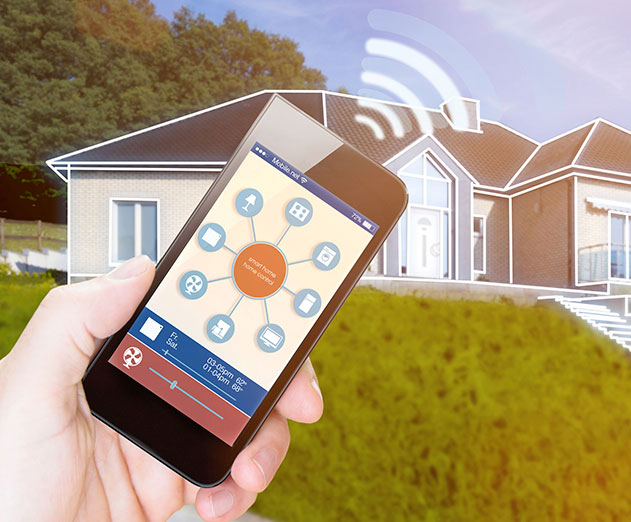IoT
The smart home effect on IIoT facilities
Wednesday, May 10, 2017

|
Saar Yoskovitz |
Knowing that the IIoT is not just a perk but a prerogative, here are three things to keep in mind as your own facility gears up for adoption.
The backbone of many science fiction plots just a few short years ago - smart machines, homes and cities - are now all around us thanks to the Internet of Things (IoT). Fitbits track and analyze physical attributes from stairs climbed to quality of sleep. By simply saying “Alexa,” Amazon Echo can deliver you with today’s weather forecast or play your favorite music as you cook breakfast. Entire cities are now looking to IoT solutions to solve traffic congestion issues and reduce noise, crime and pollution - among a host of other issues.
Soon facilities will witness similar levels of automation. Once only available to the most well-funded enterprises, the Industrial Internet of Things (IIoT) now touches facilities of all sizes, allowing managers to reap the efficiency and cost-savings of machine learning, big data technology (including sensor data) and machine-to-machine communications. Harnessing this technology and connectivity is increasingly a major component of becoming a smart facility of the future - and in remaining competitive in today’s global market.
In simplest terms, the IoT refers to a network of connected objects that collect and exchange data using embedded sensors. The industrial subset, the IIoT, delivers ‘smart’ technology necessary for a productive and efficient facility environment. Smart thermostats, for example, use external and internal data to automatically maintain optimum temperatures, effectively reducing outages and ensuring business continuity. Similarly, automated lighting systems optimize energy use. In the industrial sector, sensor-enabled generators and predictive analytics tools help plants prevent unplanned downtime, relieving the stress on energy demand and reducing environmental impact.
Many facility managers might approach the modernization of their facilities with an ‘if it isn’t broken, don’t fix it’ mindset, fully trusting their existing strategies of spreadsheets and manual inspections. The problem with this is consumer conditioning. As end users become acclimated to their own automated residential tools, such as Nest thermostats and Ring doorbells, they will come to expect similarly tech-savvy services from utilities providers, web servers, office spaces and everywhere else - behind which facility departments dwell. Rest assured that others in the industrial sector are automating their facilities to meet demands and improve service levels. If your facility lags, it will soon be seen as arcane and even wasteful, as automation is changing the standards to align with expectations and efficiencies.
Knowing that the IIoT is not just a perk but a prerogative, here are three things to keep in mind as your own facility gears up for adoption:
Unlike buying a server or a socket wrench, you don’t just acquire the IIoT. Adoption happens in the same way it does for the IoT - one application for a practical purpose at a time.
Through Fitbits, consumers grew accustomed to seeing their health stats charted, and reacting accordingly to improve their numbers. Amazon’s “Alexa” and Apple’s “Siri” are acclimating consumers to talking with technology. Over time, these iterative adoptions will result in a wider network of the IoT, and the IIoT will follow in tandem.
In facilities, the procession is gradual and for most begins with adoption of an automated lighting system and review of energy efficiency results. Predictive software solutions come next and are applied to maintenance strategies as part of a shift from preventive maintenance to a predictive maintenance (PdM) approach. PdM allows technicians to identify weaknesses or malfunctions before machines break to avoid time-consuming diagnostics and reduce total maintenance overhead.
Jotting down maintenance schedules in spreadsheets helps people analyze when to change a belt or add lubricant. PdM reorganizes the equation by evaluating sensor data in real-time to suggest upcoming maintenance needs by machine. This predictive quality takes the guesswork and analysis out of the human equation, making facilities management less hands-on and more efficient.
Released from the duties of analyzing breakage potential and schedules themselves, managers can turn their attention to other ways to upgrade or optimize facilities in order to benefit the business.
While the Roomba self-driving vacuum cleaner might be one of the IoT’s biggest flops (and main subject of numerous viral cat videos), the same isn’t holding true for robotics in the IIoT. From self-driving tractors to robotic assembly lines, the robot and drone workforce is rapidly finding a place in industrial applications of all kinds - removing menial tasks from workers’ to-do lists and freeing up valuable time.
In terms of facilities, this will likely mean a shift in workforce demands, as automated lawn mowers, robotic vacuums and floor scrubbers, battery-powered medical carts, environmental sampling robots and laundry services, to name a few, take over the mundane and repetitive tasks, human workers will move to essential overlord positions, managing and optimizing the robotic fleet. This will require aptitude with the IIoT way of thinking and knowledge around analytics software, so in future-proofing your facility, it is important to establish an early IIoT literacy that lays the groundwork for future technology adoptions.
Transition periods are always a challenge, but by thinking ahead about IIoT, facilities can avert the crisis of becoming a laggard. By acclimating slowly, facilities can gradually familiarize their procedures and operations so when that first robot cleaner enters the scene, it won’t be a shock or surprise. The facilities of tomorrow are indeed smart, but now is the time to make sure your team is too.
This content is made possible by a guest author, or sponsor; it is not written by and does not necessarily reflect the views of App Developer Magazine's editorial staff.
Soon facilities will witness similar levels of automation. Once only available to the most well-funded enterprises, the Industrial Internet of Things (IIoT) now touches facilities of all sizes, allowing managers to reap the efficiency and cost-savings of machine learning, big data technology (including sensor data) and machine-to-machine communications. Harnessing this technology and connectivity is increasingly a major component of becoming a smart facility of the future - and in remaining competitive in today’s global market.
IoT and IIoT
In simplest terms, the IoT refers to a network of connected objects that collect and exchange data using embedded sensors. The industrial subset, the IIoT, delivers ‘smart’ technology necessary for a productive and efficient facility environment. Smart thermostats, for example, use external and internal data to automatically maintain optimum temperatures, effectively reducing outages and ensuring business continuity. Similarly, automated lighting systems optimize energy use. In the industrial sector, sensor-enabled generators and predictive analytics tools help plants prevent unplanned downtime, relieving the stress on energy demand and reducing environmental impact.
Many facility managers might approach the modernization of their facilities with an ‘if it isn’t broken, don’t fix it’ mindset, fully trusting their existing strategies of spreadsheets and manual inspections. The problem with this is consumer conditioning. As end users become acclimated to their own automated residential tools, such as Nest thermostats and Ring doorbells, they will come to expect similarly tech-savvy services from utilities providers, web servers, office spaces and everywhere else - behind which facility departments dwell. Rest assured that others in the industrial sector are automating their facilities to meet demands and improve service levels. If your facility lags, it will soon be seen as arcane and even wasteful, as automation is changing the standards to align with expectations and efficiencies.
Three Things to Know
Knowing that the IIoT is not just a perk but a prerogative, here are three things to keep in mind as your own facility gears up for adoption:
1.) IIoT Happens Over Time
Unlike buying a server or a socket wrench, you don’t just acquire the IIoT. Adoption happens in the same way it does for the IoT - one application for a practical purpose at a time.
Through Fitbits, consumers grew accustomed to seeing their health stats charted, and reacting accordingly to improve their numbers. Amazon’s “Alexa” and Apple’s “Siri” are acclimating consumers to talking with technology. Over time, these iterative adoptions will result in a wider network of the IoT, and the IIoT will follow in tandem.
In facilities, the procession is gradual and for most begins with adoption of an automated lighting system and review of energy efficiency results. Predictive software solutions come next and are applied to maintenance strategies as part of a shift from preventive maintenance to a predictive maintenance (PdM) approach. PdM allows technicians to identify weaknesses or malfunctions before machines break to avoid time-consuming diagnostics and reduce total maintenance overhead.
2.) It’s a Change of Philosophy
Jotting down maintenance schedules in spreadsheets helps people analyze when to change a belt or add lubricant. PdM reorganizes the equation by evaluating sensor data in real-time to suggest upcoming maintenance needs by machine. This predictive quality takes the guesswork and analysis out of the human equation, making facilities management less hands-on and more efficient.
Released from the duties of analyzing breakage potential and schedules themselves, managers can turn their attention to other ways to upgrade or optimize facilities in order to benefit the business.
3.) It Lays the Foundation for Robotics
While the Roomba self-driving vacuum cleaner might be one of the IoT’s biggest flops (and main subject of numerous viral cat videos), the same isn’t holding true for robotics in the IIoT. From self-driving tractors to robotic assembly lines, the robot and drone workforce is rapidly finding a place in industrial applications of all kinds - removing menial tasks from workers’ to-do lists and freeing up valuable time.
In terms of facilities, this will likely mean a shift in workforce demands, as automated lawn mowers, robotic vacuums and floor scrubbers, battery-powered medical carts, environmental sampling robots and laundry services, to name a few, take over the mundane and repetitive tasks, human workers will move to essential overlord positions, managing and optimizing the robotic fleet. This will require aptitude with the IIoT way of thinking and knowledge around analytics software, so in future-proofing your facility, it is important to establish an early IIoT literacy that lays the groundwork for future technology adoptions.
The Smart Facility of Tomorrow
Transition periods are always a challenge, but by thinking ahead about IIoT, facilities can avert the crisis of becoming a laggard. By acclimating slowly, facilities can gradually familiarize their procedures and operations so when that first robot cleaner enters the scene, it won’t be a shock or surprise. The facilities of tomorrow are indeed smart, but now is the time to make sure your team is too.
This content is made possible by a guest author, or sponsor; it is not written by and does not necessarily reflect the views of App Developer Magazine's editorial staff.

Become a subscriber of App Developer Magazine for just $5.99 a month and take advantage of all these perks.
MEMBERS GET ACCESS TO
- - Exclusive content from leaders in the industry
- - Q&A articles from industry leaders
- - Tips and tricks from the most successful developers weekly
- - Monthly issues, including all 90+ back-issues since 2012
- - Event discounts and early-bird signups
- - Gain insight from top achievers in the app store
- - Learn what tools to use, what SDK's to use, and more
Subscribe here









